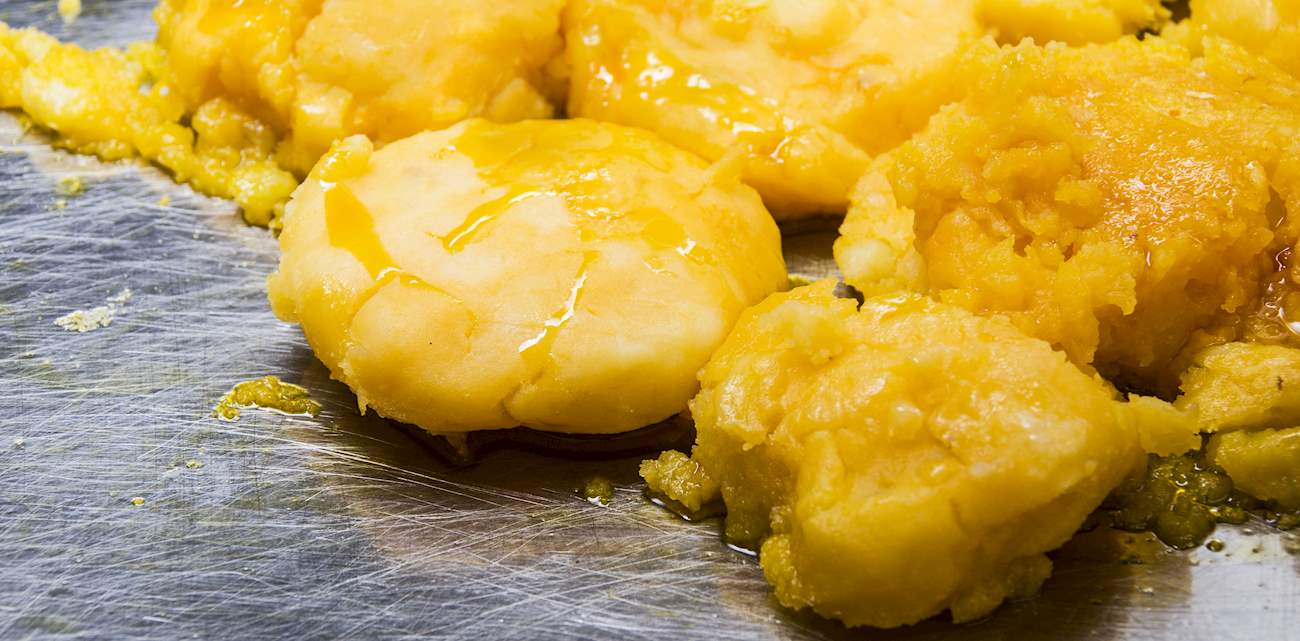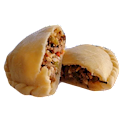Empanadas argentinas, or Argentinian empanadas, make up a group of traditional Argentinian pastries filled with a variety of ingredients, from meat to cheese and vegetables. Although they are mostly enjoyed in their savory form, there are sweet dessert varieties filled with ingredients such as dulce de leche and quince.
The dough, typically made with wheat flour, is rolled thin and folded over a filling, and the resulting parcel is then baked or fried to golden perfection. Traditional empanadas often feature ingredients such as ground beef, onions, and spices, giving them a robust and savory flavor.
VARIATIONS OF Empanadas Argentinas
MOST ICONIC Empanadas Argentinas
View moreMAIN INGREDIENTS
Llapingachos are typical Ecuadorian potato patties that are often served with a spicy peanut sauce on the side. They consist of cheese and mashed potatoes. The combination of those ingredients is flattened and cooked on a griddle until it develops a golden-brown color.
Llapingachos are traditionally served as a side dish along with avocadoes, salads, fried eggs, pork, and chorizo.
Serve with
MAIN INGREDIENTS
Anticucho de corazon is a traditional dish originating from Peru, consisting of beef heart skewers. The dish is made with a combination of beef heart, oil, red wine vinegar, garlic, oregano, cumin, salt, and aji panca hot pepper paste. The beef heart is cut into cubes and marinated in a combination of all other ingredients.
The cubes are then skewered and grilled until fully cooked and slightly charred. These beef heart skewers are traditionally served with accompaniments such as thick slices of boiled potatoes, corn, and aji amarillo sauce on the side as a dip. It's recommended to enjoy anticucho de corazon with a bottle of ice-cold beer.
MOST ICONIC Anticuchos de corazon
View moreMAIN INGREDIENTS
One of Brazil's favorite street foods, coxinha (lit. little thigh) is a crispy croquette filled with chicken meat and cream cheese that is cleverly shaped into a chicken drumstick, then breaded and deep-fried. Coxinha originated around São Paulo in the 19th century, and by the 1950s it spread to Rio de Janeiro and Paraná, having now become one of the most popular salgados (savory appetizers) across the country.
Legend has it that coxinha was first made for the Brazilian princess Isabel's son who only liked chicken thigh meat. However, according to food historians, it was probably invented during the industrialization of São Paulo to be marketed as a cheaper and more durable substitute to traditional chicken cuts that were sold at the gates of local factories as snacks for the workers.
MOST ICONIC Coxinha
View moreMAIN INGREDIENTS
This is an extreme version of a steak sandwich – filled with thinly sliced lomo steak, tomatoes, onions, lettuce, mayonnaise, chimichurri sauce, ham, cheese, and a fried egg, sandwich de lomo or lomito is a behemoth of a sandwich that is sure to satiate even the hungriest consumers.
However, this delicious sandwich is open to innovation – some might substitute the steak with pork, or put aubergine slices into it, along with any other ingredient that comes to mind. Popular both in Argentina and Uruguay, it can easily be found at numerous street carts dispersed throughout the metropolitan areas of both countries.
MOST ICONIC Sandwich de lomo
View moreThese empanadas are a specialty of the region of Tucumán, and they are quite different than numerous empanadas found in Buenos Aires. Tucumanas are typically handmade according to old, traditional recipes, and are characterized by a crispy dough and ideal proportions of dough and fillings.
The dough is made with wheat flour and beef fat, and it is then usually filled with beef, chicken, or tripe, along with other ingredients such as onions, hard-boiled eggs, paprika, and cumin. Authentic Tucumanas should be baked in a clay oven, and it is best to enjoy them with a glass of local wine on the side.
MAIN INGREDIENTS
Anticucho de pescado is a traditional dish originating from Peru, consisting of fish on skewers. The dish is prepared by marinating firm white fish in a combination of garlic, paprika, salt, vinegar, lime juice, oil, cumin, and black pepper. The fish is then cut into cubes, placed on skewers and grilled until fully cooked.
Once done, the fish skewers are served on a platter and the dish is traditionally accompanied by thick sliced of boiled potatoes, lettuce, corn, and aji amarillo sauce on the side for dipping. It's recommended to garnish anticucho de pescado with lemon wedges.
Pastel mandi’o is a doughy snack made with cornflour, boiled cassava, fat, and eggs. It is stuffed with a mixture of minced meat, boiled eggs, and seasonings. These snacks are fried in oil or fat and served hot. The dough is sweet, and the filling is replete with flavors, giving the dish a distinctive taste. Mandi’o means cassava in the Guarani language, and it is this ingredient which gives a unique Guarani twist to the dish.
These snacks resemble empanadas, mainly differing from the latter in the use of cornflour and cassava, which are typical for Paraguay. They encompass the authentic taste of Paraguayan cuisine and are a popular street food served in local bars, particularly during the festival of San Juan.
MAIN INGREDIENTS
Bondipan (or bondiola) is a classic sandwich originating from Argentine. Similar to the more famous choripan, this sandwich is made with bondiola de cerdo, pork shoulder that's roasted or grilled to perfection and served in crusty french bread.
The succulent and salty pork is drizzled with lemon juice and often topped with chimichurri. If desired, a bit of chili sauce can also be added to the sandwich. The sandwich is typically sold as street food, and people usually enjoy it while standing by the bar.
MAIN INGREDIENTS
Choripán is the ultimate in Argentine street food, a sandwich consisting of a chorizo sausage and a variety of condiments in a crusty bun. It is usually consumed on the go, since it is mostly sold at street stands throughout Latin America.
The name choripán is derived from two words: chorizo, referring to the sausage, and pan, meaning bread.
MOST ICONIC Choripán
View moreTasteAtlas food rankings are based on the ratings of the TasteAtlas audience, with a series of mechanisms that recognize real users and that ignore bot, nationalist or local patriotic ratings, and give additional value to the ratings of users that the system recognizes as knowledgeable. For the “Top 48 South American Street Foods” list until March 21, 2025, 5,866 ratings were recorded, of which 2,903 were recognized by the system as legitimate. TasteAtlas Rankings should not be seen as the final global conclusion about food. Their purpose is to promote excellent local foods, instill pride in traditional dishes, and arouse curiosity about dishes you haven’t tried.











































